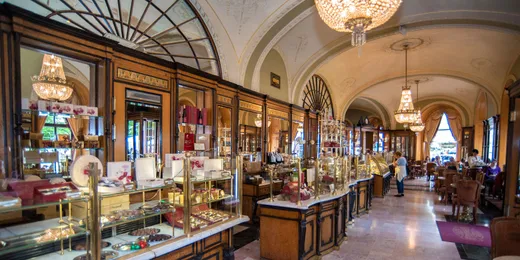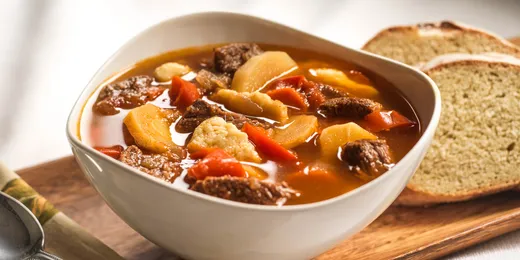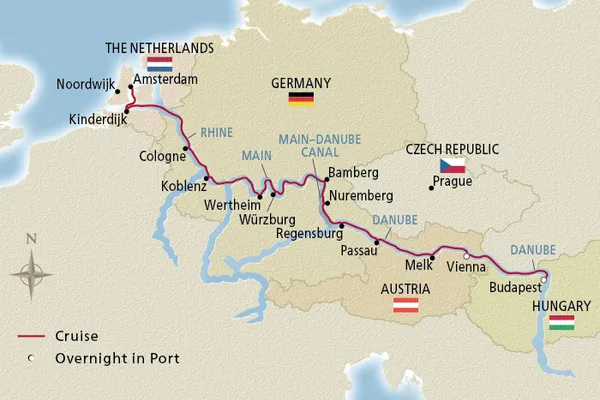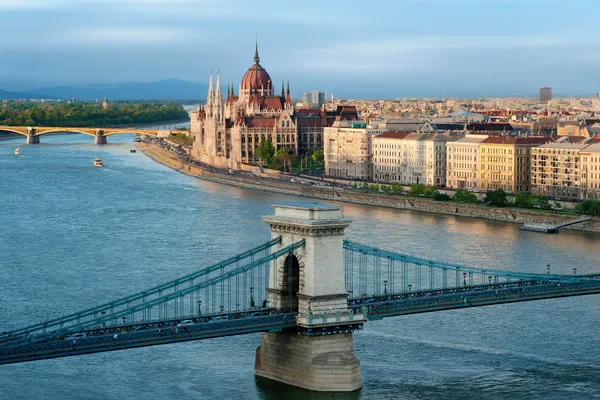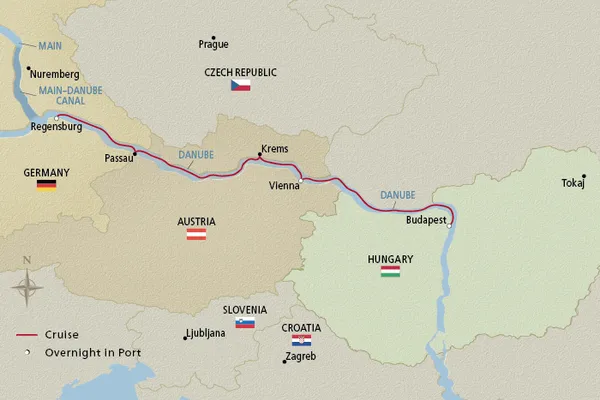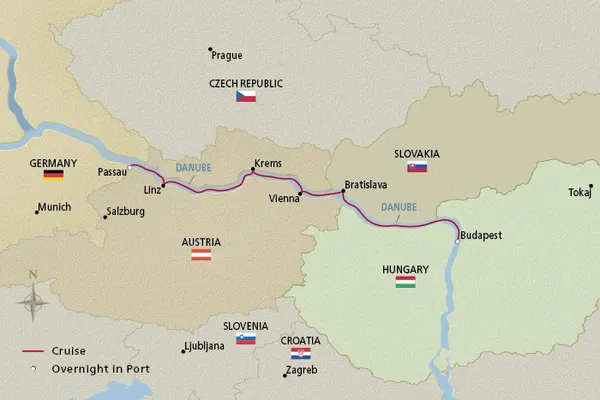
Immerse yourself in Hungary’s rich culture
Delve into to the iconic landmarks, unique traditions and captivating history that await you in Hungary. From its graceful cities to its picturesque countryside, this European country offers a variety of delights to curious travelers. Read on to learn more about a popular Magyar dessert, discover what makes music from this corner of the world so distinctive and explore the lives of two legendary Hungarians.

Hungary
Situated in the heart of Europe, landlocked Hungary is bordered by Austria, Slovakia, Romania, Serbia, Croatia and Slovenia. The country, known to Hungarians as “Magyarország,” or “Land of Magyars,” spans 35,918 sq mi. (93,027 sq km) and is divided into east and west by the Danube River. Eastern Hungary consists mostly of flat plains. In the west, rolling hills and low mountains form the Transdanubia region. The Carpathian Mountains rise in the north. More than half of Hungary’s land is arable; its rich agricultural industry can feed the entire country.
Hungary has a moderately dry continental climate, with average temperatures ranging from the mid-20s to the low 30s °F (about −4 to 0°C) in January and from the mid-60s to the low 70s °F (about 18 to 23°C) in July.
The country's magnificent capital city of Budapest, once called the “Queen of the Danube,” stands as an anchor of Hungarian culture. The city consists of two parts, Buda and Pest, which are situated on opposite sides of the Danube River. Although the city’s origins date back millennia, modern Budapest is largely an outgrowth of the Austro-Hungarian Empire during the 19th century. Today, 20 percent of Hungarians call this grand city home.
With its unique traditions, impressive architecture, picturesque scenery and famed UNESCO sites, the country has become known for its cultural treasures. Some of Hungary’s most notable landmarks include:
- Fisherman’s Bastion—Sitting atop Castle Hill on the Buda side of the Danube, Fisherman’s Bastion is a picturesque cluster of white stone towers, arches, terraces and columns that was built upon the Buda Castle walls between 1895 and 1902.
- Széchenyi Chain Bridge—Of the eight bridges that span the Danube in Budapest, the oldest and best-known is the Széchenyi Chain Bridge. Built in the 1840s and named for the 19th-century Hungarian reformer István Széchenyi, this bridge linked the towns of Buda and Pest, serving as a potent metaphor for unity.
- Buda Castle—Constructed in the 13th century and expanded to its current baroque splendor during the 18th century, this stunning edifice was home to Hungary’s kings for almost 700 years.
- Dohány Street Synagogue—This 19th-century Moorish-Revival masterpiece sits in the heart of Budapest’s historic Jewish Quarter. In the synagogue complex, visitors can browse religious relics and learn more about Budapest’s rich Jewish history and heritage.
- Cella Septichora—Recognized as a UNESCO World Heritage Site in 2000, this 4th-century Christian seven-apsed burial site allows visitors an opportunity to observe a series of brick tombs, some of which are adorned with ancient paintings depicting biblical scenes.
- Mohács National Memorial—On August 29, 1526, King Louis II experienced a decisive defeat against the Ottoman Empire on a stretch of marshland near the town of Mohács on the Danube River, leading to the collapse of the Hungarian monarchy. In 1976, the battlefield became an official national historic monument, which can still be visited today.

-
Cuisine—Hungarian rétes
One of the most popular desserts in Hungary is a flaky confection called rétes, which comes from the word réteges, meaning “layered.” This dessert, which is similar to Austria’s famed strudel, is a staple at weddings and festive occasions.
While Austrians may claim the popular pastry as their own, Hungarians may have a more valid gastronomic claim. It is likely that the pastry has Turkish origins as a type of baklava. When the Ottomans brought it to Europe in the 16th century, they would have stopped first in present-day Hungary. Over the years, the dessert was modified and eventually made its way into Viennese kitchens and bakeries. Rétes continued spreading westward until it was the toast of the entire Austro-Hungarian Empire—but its popularity was not limited to the Hapsburg borders. In the 19th century, Paris’s Ritz Hotel offered rétes hongrois (Hungarian rétes) on its menu. Its chefs were sent to Pest to learn how to prepare the beloved treat, and the Ritz ordered its flour from Hungary to achieve a more authentic taste.
Connoisseurs will tell you that Hungarian rétes is lighter and less sweet than its Austrian counterpart. The dough must be rolled paper-thin—so transparent, according to a Hapsburg Emperor’s chef, that “one could read a love letter through it.” To achieve this, the dough must be very elastic, which is why Hungarian cooks use a special pastry flour with a high gluten content.
Another distinctive feature of Hungarian rétes is that it is very generously stuffed. The most popular filling is apple, which is called almás rétes. Other favorites include cherries, poppy seeds, pumpkin with cinnamon, walnuts and raisins, cottage cheese sweetened with sugar and vanilla, apricots and plums. There are also savory versions filled with spinach, mushrooms, pumpkin and meat. One version, called káposztás rétes, features cabbage seasoned with caraway seed.
These flaky delights have become popular across the globe, but they are especially so in Eastern Europe. The dessert is called zavitek in Slovenia, závin in the Czech Republic, savijača or štrudla in Croatia and gibanica in Serbia. But in Hungary, you will probably just call your authentic rétes “a little slice of heaven.”
-
Culture—Hungarian music
Hungary has a long and rich musical history. Though two of its most popular genres, folk and classical, seem very different, each has had a profound influence on the other.
The Magyar people were the first Hungarians descended from the intermingling of the eastern Turkic and more northern Finno-Ugric people. This cultural blend had a significant impact on music, creating a unique synthesis of styles. One of Hungary’s most famous composers and musicologists, Zoltán Kodály, identified Hungarian folk songs that may have been 2,500 years old and were also extant in Russia. Other ethnomusicologists have linked Hungarian music to Anatolian Turkish, Chinese, Mongol, Chuvash and other ancient Asian musical forms.
The study and categorization of these old folk forms gained major momentum during the late 19th-century romantic nationalism movement. Kodály, along with renowned Hungarian composer Béla Bartók, employed many of these folk themes in his music. This was quite a departure in the classical music world, which until then had been dominated by Germanic influences.
During the 19th century, Hungarian Roma orchestras became very popular throughout Europe. Their folk styles, such as the csárdás and verbunkos dances, were conflated with Hungarian folk styles, despite the insistence of musical experts that the two were very different. Nonetheless, it was hugely popular, and even the premier Hungarian classical composer and performer of the day, Franz (Ferenc) Liszt, echoed Roma musical tropes in performances of works such as the Hungarian Dances and Rhapsodies. Today, Romany music has grown in popularity and has fused with jazz, pop, rock and other modern styles.
Similarly, the klezmer music of Hungary’s Ashkenazi Jews—traditionally played at weddings—still echoes on the Budapest stages. With its dizzying scales and expressive emotions, designed to mimic human sighs, cries and shouts of joy, it is one of the most exuberant folk performance forms you can see.
Today, the classical music of Bartók can be heard at the Hungarian State Opera House. Meanwhile, several times a week at the Danube Palace, folk ensembles preserve the rhythm and dance of Hungarian and Roma music. Klezmer musicians perform at Spinoza Étterem or the Fonó Music Hall.
-
History—Two famous Hungarians
Since emerging as a distinct political entity during the late 9th century, Hungary has nurtured many remarkable individuals. The country’s riveting history abounds with legendary rulers, brilliant scholars and innovative artists. Read on to learn about two of its most esteemed residents.
Árpád (ca. 845–907 AD)
Second grand prince of the Magyars, Árpád is hailed as the forefather of all Hungarians, and many believe him to have been descended from Attila the Hun. In the 9th century, the tribes that would become the first Hungarian nation were part of the Khazar Empire in Eurasia. Árpád led ten tribes out of Khazar, but with the ever-shifting boundaries of power, Árpád knew he needed an empire on his side. He allied his people with the Byzantine Empire, who had Emperor Simeon I of Bulgaria in their crosshairs. Árpád and the Byzantine army defeated Simeon I, forcing him into making peace with Byzantium. But Simeon I would not go quietly. He forged an alliance with the Pechenegs, a semi-nomadic tribe of Turkic people, and together they forced the Magyars from the region.Árpád's tribes fanned out into Central Europe, but around 900 AD, many settled back into what is now western Hungary, eastern Austria and the northern Balkans. Up to a quarter million Magyar are thought to have resettled in this area under Árpád’s rule and, together with his other tribes, declared him their grand prince. Árpád’s legacy is Hungary itself. Historians agree that he was largely responsible for bringing together a confederation of tribes into one unified Hungary. The Árpád Dynasty went on to rule the Kingdom of Hungary until 1301.
Béla Bartók (1881–1945)
From the moment four-year-old Béla Bartók mastered his first 40 piano pieces, he was on a course to change 20th-century music. Though he never garnered the fame of Richard Strauss or Franz Liszt, his life’s work led him to rethink the harmonic qualities that had defined music for 200 years. His stirring symphonies also brought a renewed sense of national pride to music composition.The influence of Bartók’s early life on his career is clear. Born to a multiethnic family of simple means—his father was Hungarian and his mother Serbian—he came to value ancestry from an early age. As a student at Budapest’s Royal Academy of Music, his interest in regional folk music led him to travel throughout Hungary, Romania and Bulgaria, collecting melodies whose roots lay in nomadic Romany culture. Soon he was composing pieces that drew on peasant traditions. In the hands of Bartók, foot-tapping Romany folk tunes—traditionally played on crude instruments—became symphonic wonders.
Hungary Highlights
A journey through this charming European country offers visitors the opportunity to engage with Hungary’s storied past, distinctive customs, and inspiring arts. Here are some of the remarkable sights and activities you may experience on a voyage through Hungary:
- Visit sprawling Buda Castle, built in the 13th century
- Take in panoramic views of Budapest from Fisherman’s Bastion
- Cross the Danube River on Budapest’s graceful Chain Bridge
- Explore a 4th-century, UNESCO-listed burial site in Pécs
- Attend a rousing performance by Puszta’s legendary horsemen
- Learn about the history of paprika in enchanting Kalocsa
- Sip full-bodied red wines in the Villány wine region
- Explore the charming town of Mohács
- Discover Pécs, a picturesque city with Mediterranean flair
- Sample goulash, a hearty beef stew and Hungary’s national dish
Destination Insight Videos
-
Shopping in Budapest (0:34)
Looking for the perfect gift? Join Karine at her favorite shop in Budapest, Hungary: the venerable Café Gerbeaud, purveyors of fine chocolates.
-
At Home in Budapest with Kinga & Eszter (21:44)
Discover the best of Budapest with two expert Viking guides, Eszter Pozsár and Kinga Tittel, as they each highlight a different side of the Danube River with a focus on hilly Buda and majestic Pest. As someone who naturally loves to share her knowledge of the city with guests and family, Kinga has been a tour guide in and around Budapest for more than a decade, while Eszter has been working as a local guide for 30 years and has been conducting tours for Viking since we began sailing in Hungary. From Buda to Pest, learn insightful tips on how to explore this delightful city from a local perspective as Kinga and Eszter take you on a tour while answering viewers’ questions during this livestream.
-
Cooking with Karine: Goulash (3:35)
Explore Budapest’s Great Market Hall and learn how to make goulash, Hungary’s rich, hearty dish seasoned with paprika and packed with flavor.
Hungary Travel FAQ
All-Inclusive Itineraries—Hungary
Choose one of our enriching, all-inclusive voyages and discover the many benefits of exploring in Viking comfort.



